YAMAHA XL 1200 2001 Owners Manual
Manufacturer: YAMAHA, Model Year: 2001, Model line: XL 1200, Model: YAMAHA XL 1200 2001Pages: 131, PDF Size: 8.12 MB
Page 91 of 131
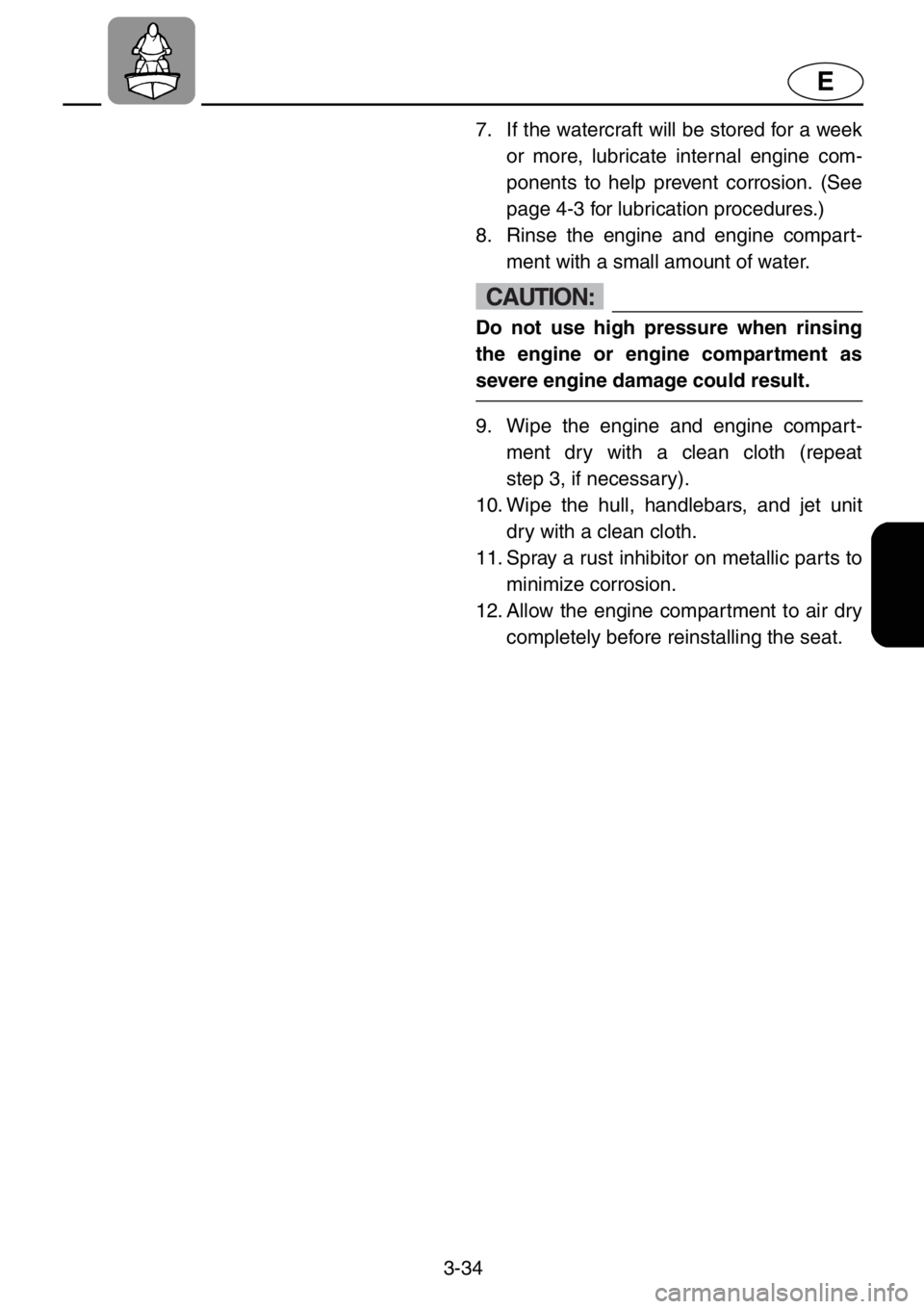
3-34
E
7. If the watercraft will be stored for a week
or more, lubricate internal engine com-
ponents to help prevent corrosion. (See
page 4-3 for lubrication procedures.)
8. Rinse the engine and engine compart-
ment with a small amount of water.
CAUTION:
Do not use high pressure when rinsing
the engine or engine compartment as
severe engine damage could result.
9. Wipe the engine and engine compart-
ment dry with a clean cloth (repeat
step 3, if necessary).
10. Wipe the hull, handlebars, and jet unit
dry with a clean cloth.
11. Spray a rust inhibitor on metallic parts to
minimize corrosion.
12. Allow the engine compartment to air dry
completely before reinstalling the seat.
Page 92 of 131
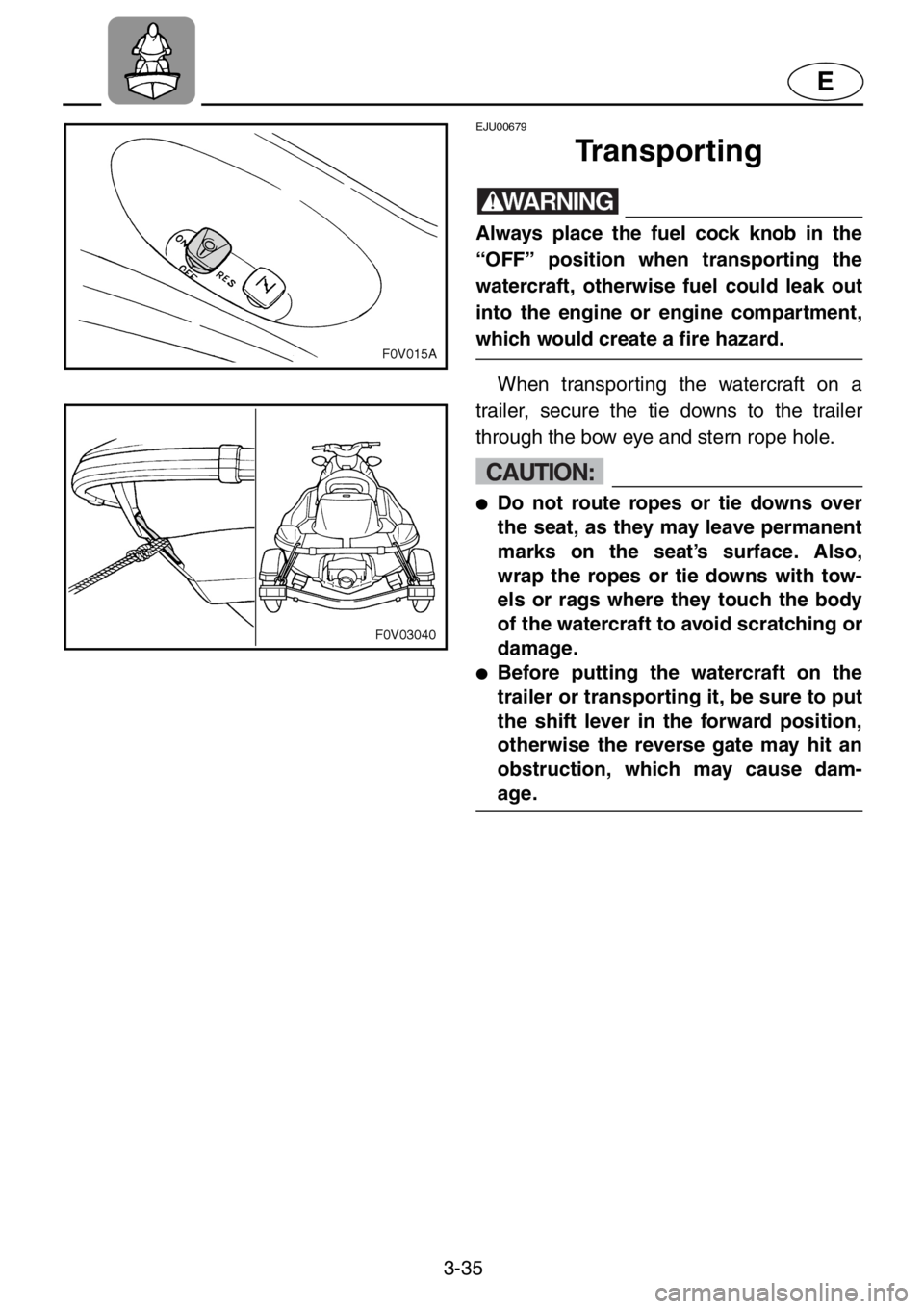
3-35
E
EJU00679
Transporting
WARNING
Always place the fuel cock knob in the
“OFF” position when transporting the
watercraft, otherwise fuel could leak out
into the engine or engine compartment,
which would create a fire hazard.
When transporting the watercraft on a
trailer, secure the tie downs to the trailer
through the bow eye and stern rope hole.
CAUTION:
●Do not route ropes or tie downs over
the seat, as they may leave permanent
marks on the seat’s surface. Also,
wrap the ropes or tie downs with tow-
els or rags where they touch the body
of the watercraft to avoid scratching or
damage.
●Before putting the watercraft on the
trailer or transporting it, be sure to put
the shift lever in the forward position,
otherwise the reverse gate may hit an
obstruction, which may cause dam-
age.
Page 93 of 131
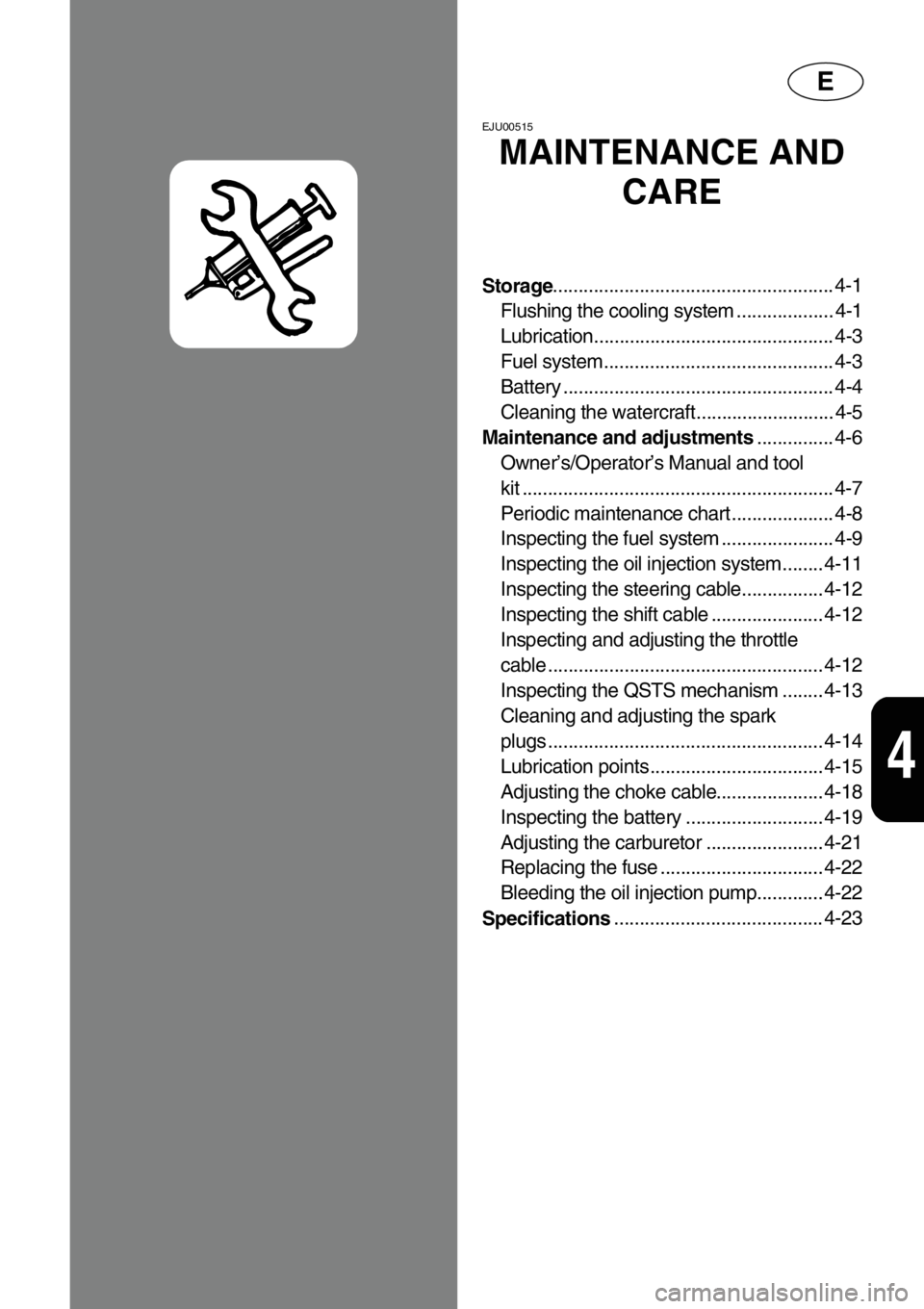
E
4
EJU00515
MAINTENANCE AND
CARE
Storage....................................................... 4-1
Flushing the cooling system ................... 4-1
Lubrication............................................... 4-3
Fuel system............................................. 4-3
Battery ..................................................... 4-4
Cleaning the watercraft........................... 4-5
Maintenance and adjustments............... 4-6
Owner’s/Operator’s Manual and tool
kit ............................................................. 4-7
Periodic maintenance chart .................... 4-8
Inspecting the fuel system ...................... 4-9
Inspecting the oil injection system........ 4-11
Inspecting the steering cable................ 4-12
Inspecting the shift cable ...................... 4-12
Inspecting and adjusting the throttle
cable ...................................................... 4-12
Inspecting the QSTS mechanism ........ 4-13
Cleaning and adjusting the spark
plugs ...................................................... 4-14
Lubrication points .................................. 4-15
Adjusting the choke cable..................... 4-18
Inspecting the battery ........................... 4-19
Adjusting the carburetor ....................... 4-21
Replacing the fuse ................................ 4-22
Bleeding the oil injection pump............. 4-22
Specifications......................................... 4-23
Page 94 of 131
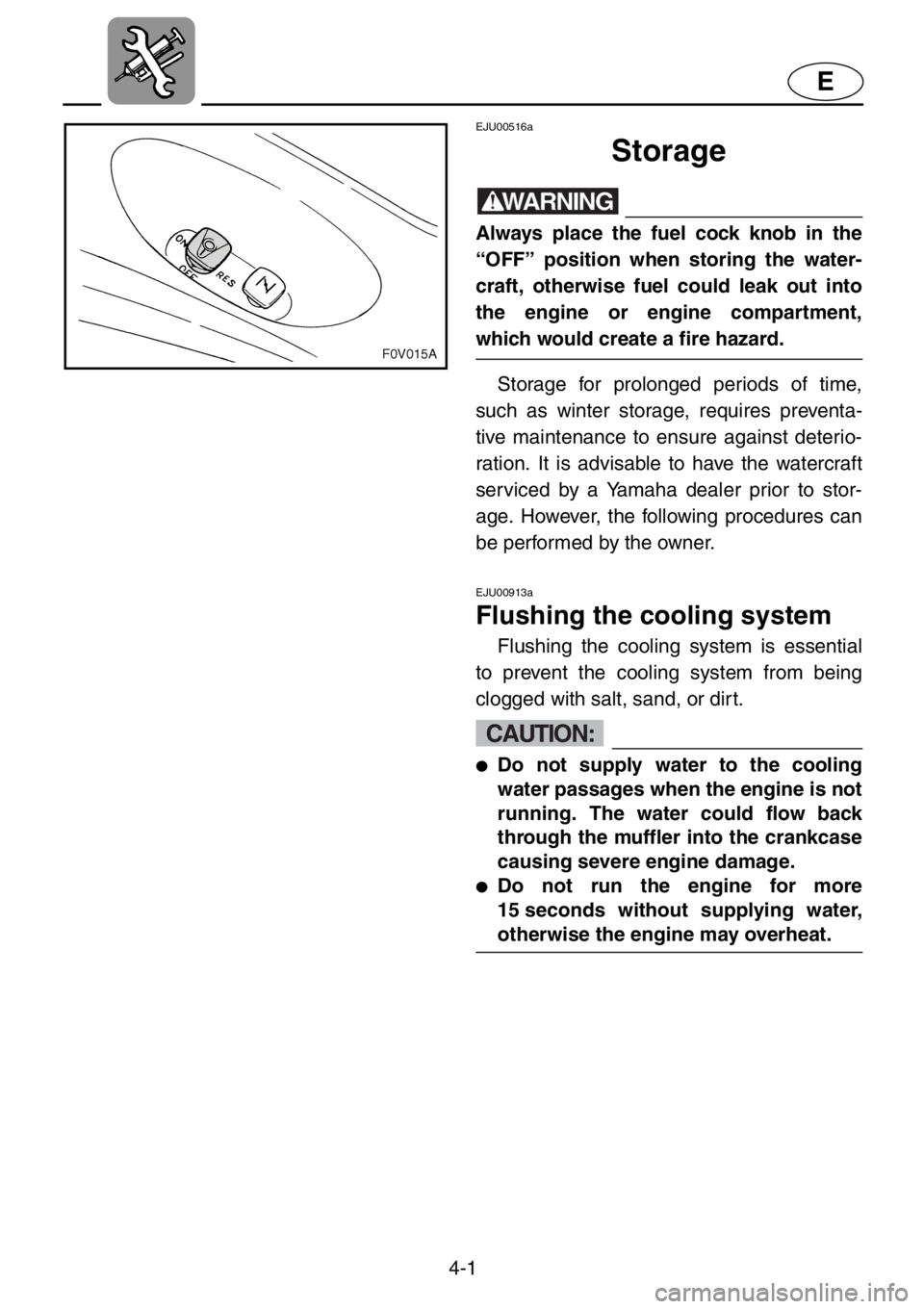
4-1
E
EJU00516a
Storage
WARNING
Always place the fuel cock knob in the
“OFF” position when storing the water-
craft, otherwise fuel could leak out into
the engine or engine compartment,
which would create a fire hazard.
Storage for prolonged periods of time,
such as winter storage, requires preventa-
tive maintenance to ensure against deterio-
ration. It is advisable to have the watercraft
serviced by a Yamaha dealer prior to stor-
age. However, the following procedures can
be performed by the owner.
EJU00913a
Flushing the cooling system
Flushing the cooling system is essential
to prevent the cooling system from being
clogged with salt, sand, or dirt.
CAUTION:
●Do not supply water to the cooling
water passages when the engine is not
running. The water could flow back
through the muffler into the crankcase
causing severe engine damage.
●Do not run the engine for more
15 seconds without supplying water,
otherwise the engine may overheat.
Page 95 of 131
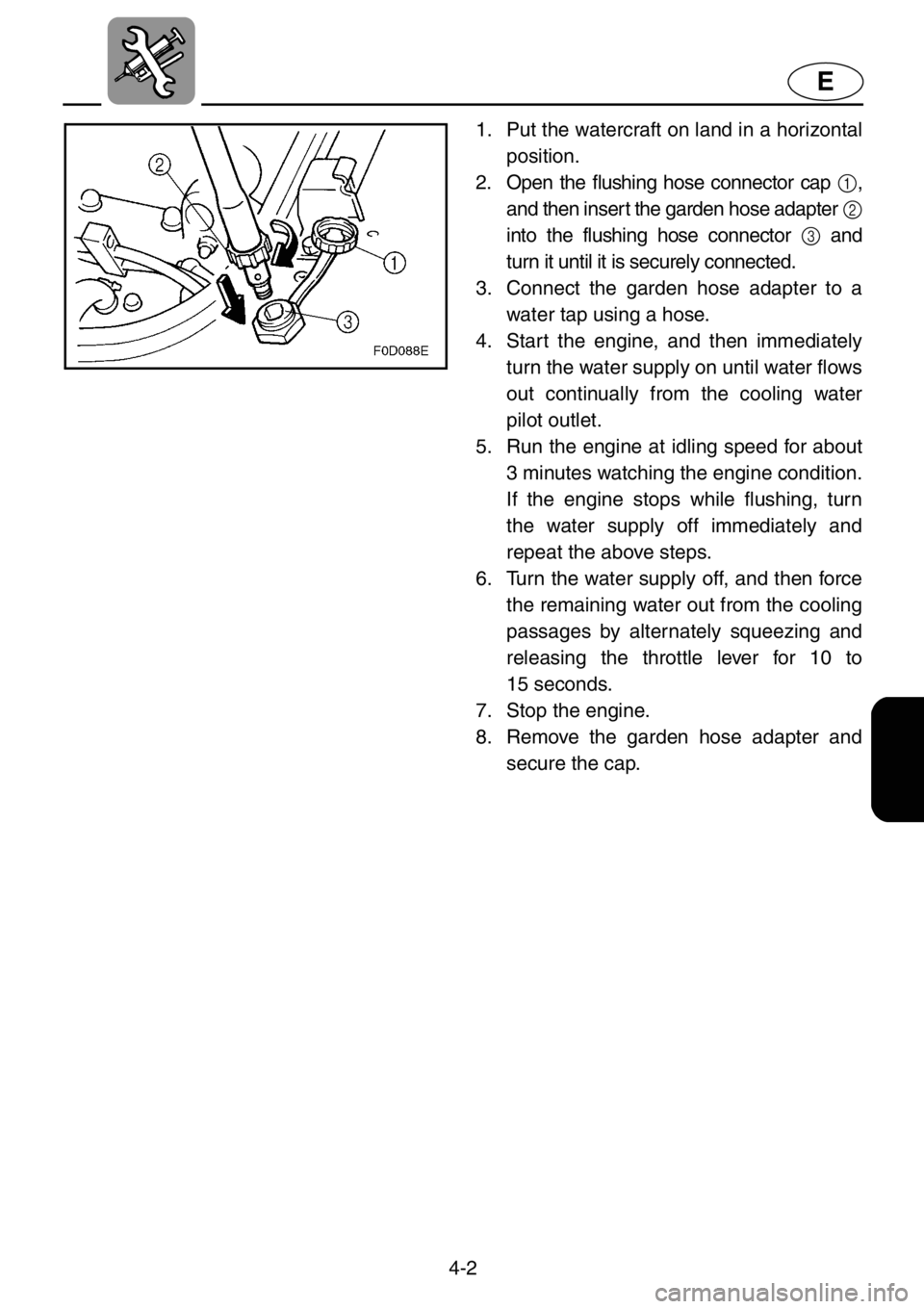
4-2
E
1. Put the watercraft on land in a horizontal
position.
2. Open the flushing hose connector cap 1,
and then inser t the garden hose adapter
2
into the flushing hose connector 3 and
turn it until it is securely connected.
3. Connect the garden hose adapter to a
water tap using a hose.
4. Start the engine, and then immediately
turn the water supply on until water flows
out continually from the cooling water
pilot outlet.
5. Run the engine at idling speed for about
3 minutes watching the engine condition.
If the engine stops while flushing, turn
the water supply off immediately and
repeat the above steps.
6. Turn the water supply off, and then force
the remaining water out from the cooling
passages by alternately squeezing and
releasing the throttle lever for 10 to
15 seconds.
7. Stop the engine.
8. Remove the garden hose adapter and
secure the cap.
Page 96 of 131
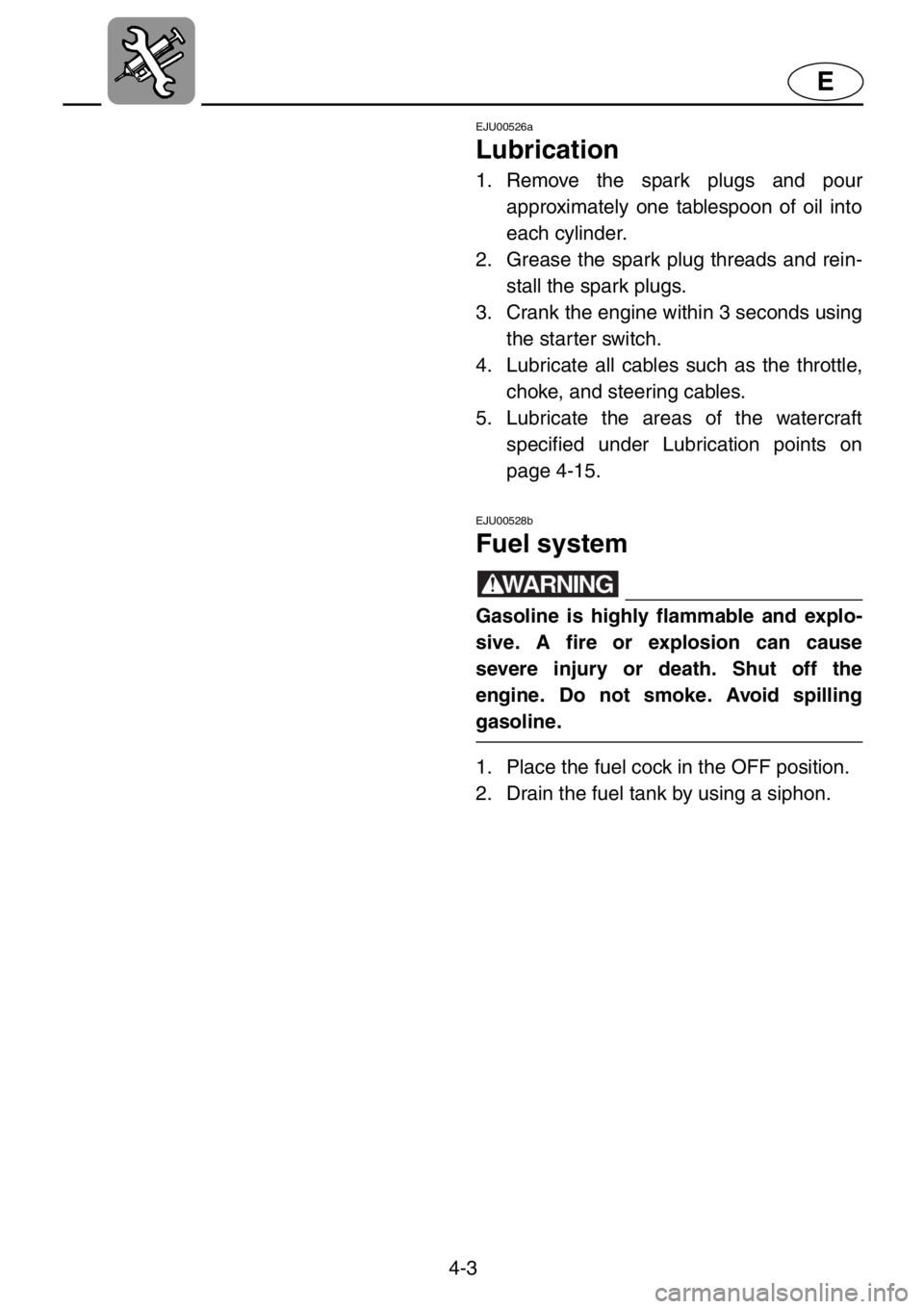
4-3
E
EJU00526a
Lubrication
1. Remove the spark plugs and pour
approximately one tablespoon of oil into
each cylinder.
2. Grease the spark plug threads and rein-
stall the spark plugs.
3. Crank the engine within 3 seconds using
the starter switch.
4. Lubricate all cables such as the throttle,
choke, and steering cables.
5. Lubricate the areas of the watercraft
specified under Lubrication points on
page 4-15.
EJU00528b
Fuel system
WARNING
Gasoline is highly flammable and explo-
sive. A fire or explosion can cause
severe injury or death. Shut off the
engine. Do not smoke. Avoid spilling
gasoline.
1. Place the fuel cock in the OFF position.
2. Drain the fuel tank by using a siphon.
Page 97 of 131
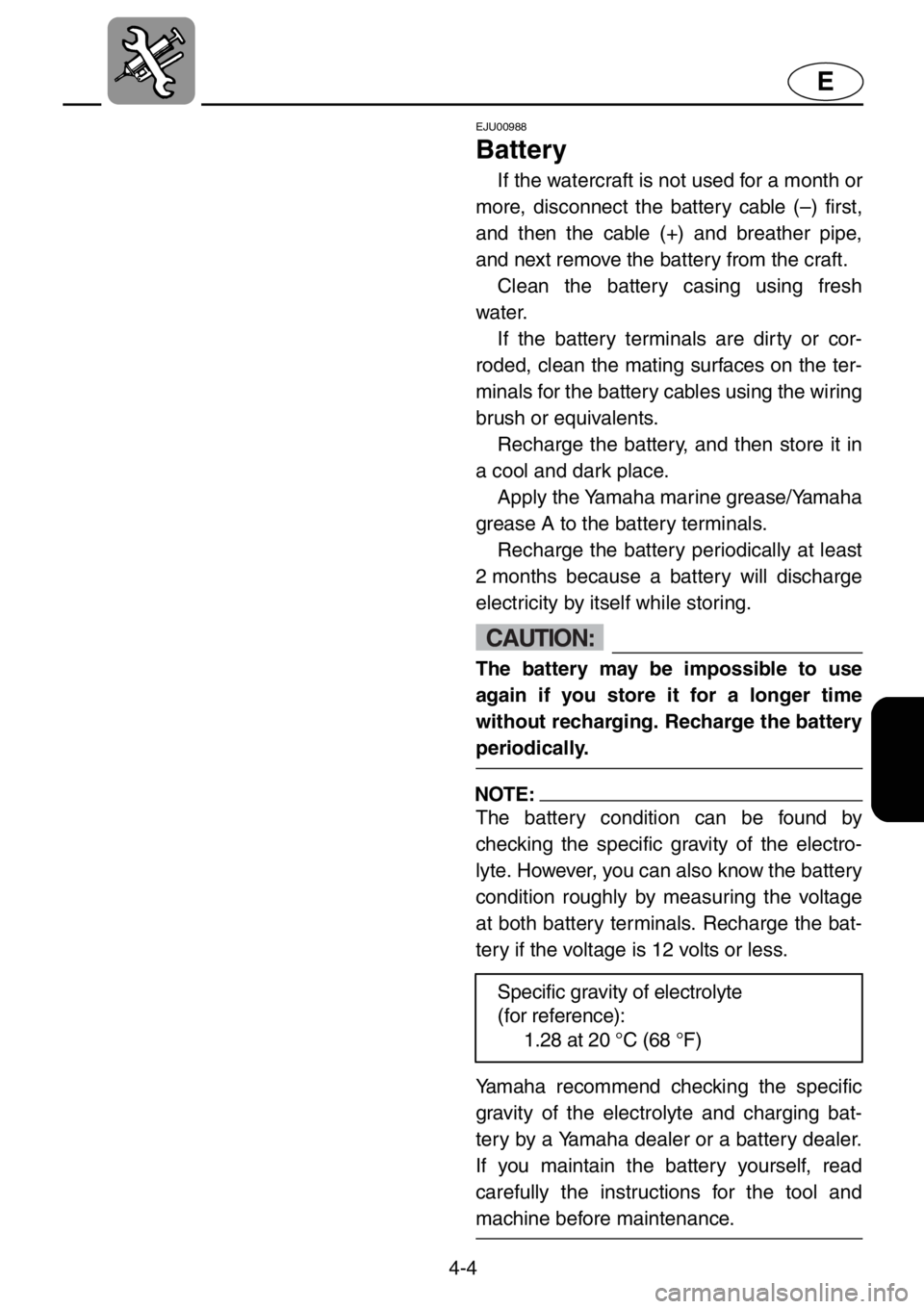
4-4
E
EJU00988
Battery
If the watercraft is not used for a month or
more, disconnect the battery cable (–) first,
and then the cable (+) and breather pipe,
and next remove the battery from the craft.
Clean the battery casing using fresh
water.
If the battery terminals are dirty or cor-
roded, clean the mating surfaces on the ter-
minals for the battery cables using the wiring
brush or equivalents.
Recharge the battery, and then store it in
a cool and dark place.
Apply the Yamaha marine grease/Yamaha
grease A to the battery terminals.
Recharge the battery periodically at least
2 months because a battery will discharge
electricity by itself while storing.
CAUTION:
The battery may be impossible to use
again if you store it for a longer time
without recharging. Recharge the battery
periodically.
NOTE:
The battery condition can be found by
checking the specific gravity of the electro-
lyte. However, you can also know the battery
condition roughly by measuring the voltage
at both battery terminals. Recharge the bat-
tery if the voltage is 12 volts or less.
Yamaha recommend checking the specific
gravity of the electrolyte and charging bat-
tery by a Yamaha dealer or a battery dealer.
If you maintain the battery yourself, read
carefully the instructions for the tool and
machine before maintenance.
Specific gravity of electrolyte
(for reference):
1.28 at 20 °C (68 °F)
Page 98 of 131

4-5
E
EJU00531
Cleaning the watercraft
Clean the watercraft before storing for a
long period.
1. Wash down the hull, handlebars, and
drive unit with fresh water.
2. Rinse the engine and bilge area with
fresh water. Drain off all water and wipe
up remaining moisture with clean, dry
rags.
3. Spray the engine’s exterior with a rust
inhibitor or lubricant.
4. Wax the hull with a non-abrasive wax.
5. Wipe all vinyl and rubber components,
such as the seat and engine compart-
ment seals, with a vinyl protectant.
Page 99 of 131

4-6
E
EJU00535a
Maintenance and
adjustments
Periodic inspection, adjustment and lubri-
cation will keep your watercraft in the safest
and most efficient condition possible. Safety
is an obligation of the watercraft owner. The
most important points of watercraft inspec-
tion, adjustment and lubrication are
explained on the following pages.
See your Yamaha dealer for genuine
Yamaha replacement parts and optional
accessories designed for your watercraft.
Remember that failures that are the result
of the installation of parts or accessories
which are not qualitatively equivalent to gen-
uine Yamaha parts are not covered by the
limited warranty.
WARNING
●Be sure to turn off the engine when
you perform maintenance unless oth-
erwise specified, otherwise an acci-
dent or injury could result from
unexpected operation, moving parts,
or electric shock. If the owner is not
familiar with watercraft servicing, this
work should be done by a Yamaha
dealer. Improperly serviced compo-
nents could fail or stop operating cor-
rectly, which could result in an
accident.
●Modifications to this watercraft not
approved by Yamaha may cause loss
of performance or excessive noise, or
render it unsafe for use. Consult a
Yamaha dealer before attempting any
changes.
Page 100 of 131
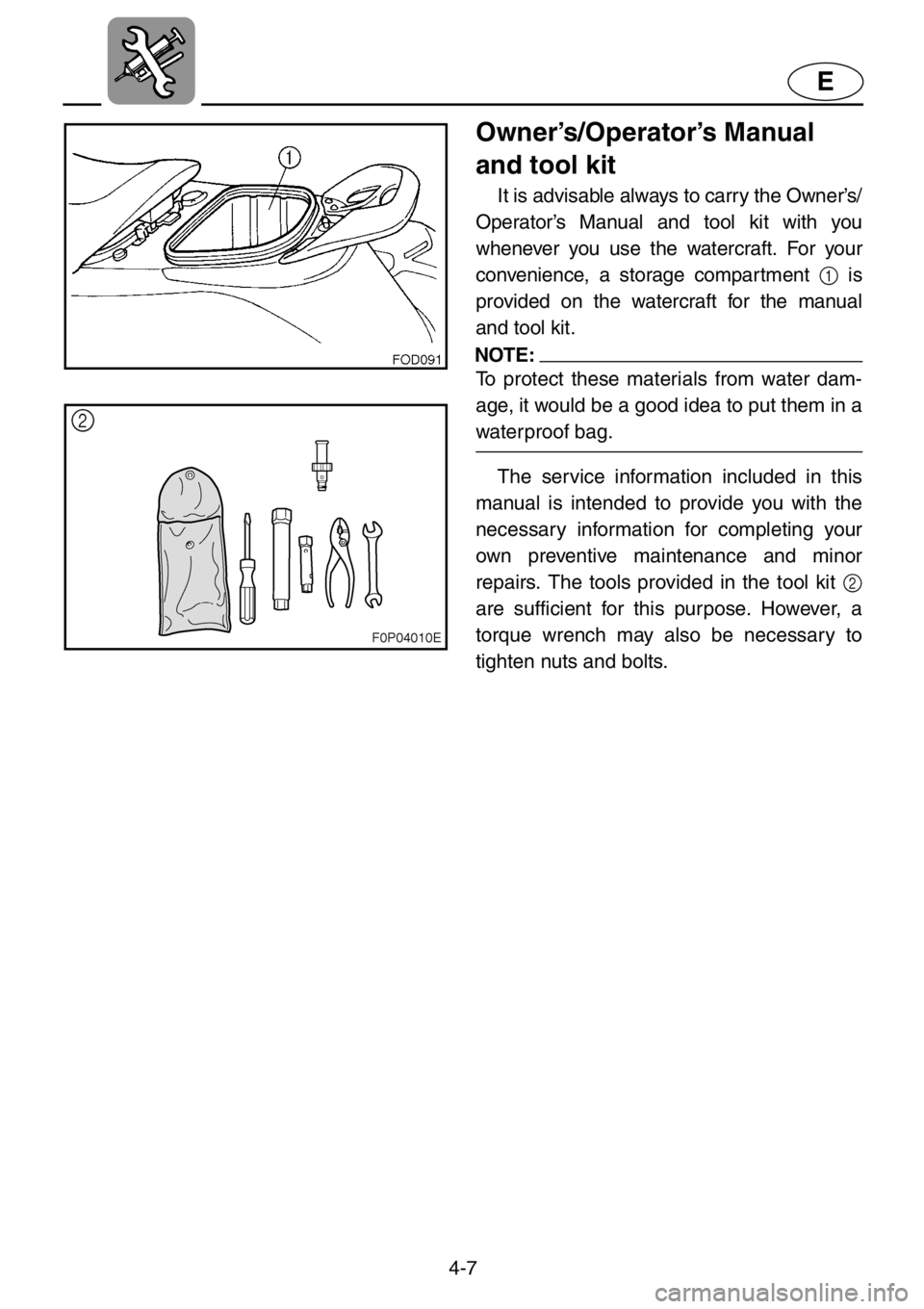
4-7
E
Owner’s/Operator’s Manual
and tool kit
It is advisable always to carry the Owner’s/
Operator’s Manual and tool kit with you
whenever you use the watercraft. For your
convenience, a storage compartment 1 is
provided on the watercraft for the manual
and tool kit.
NOTE:
To protect these materials from water dam-
age, it would be a good idea to put them in a
waterproof bag.
The service information included in this
manual is intended to provide you with the
necessary information for completing your
own preventive maintenance and minor
repairs. The tools provided in the tool kit 2
are sufficient for this purpose. However, a
torque wrench may also be necessary to
tighten nuts and bolts.